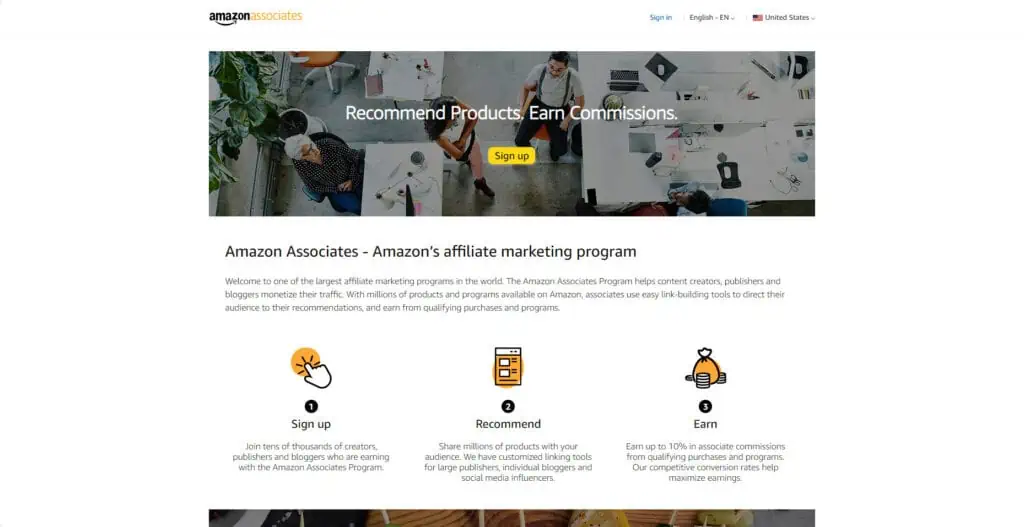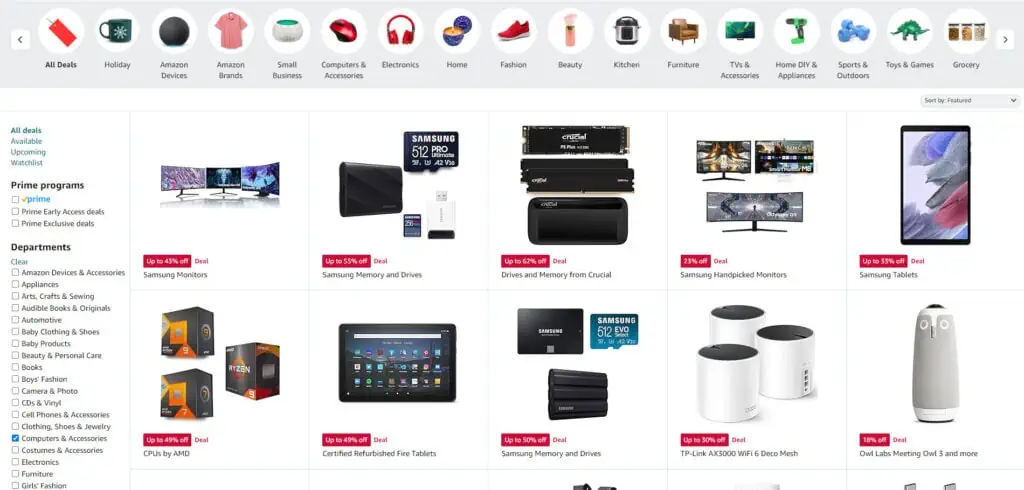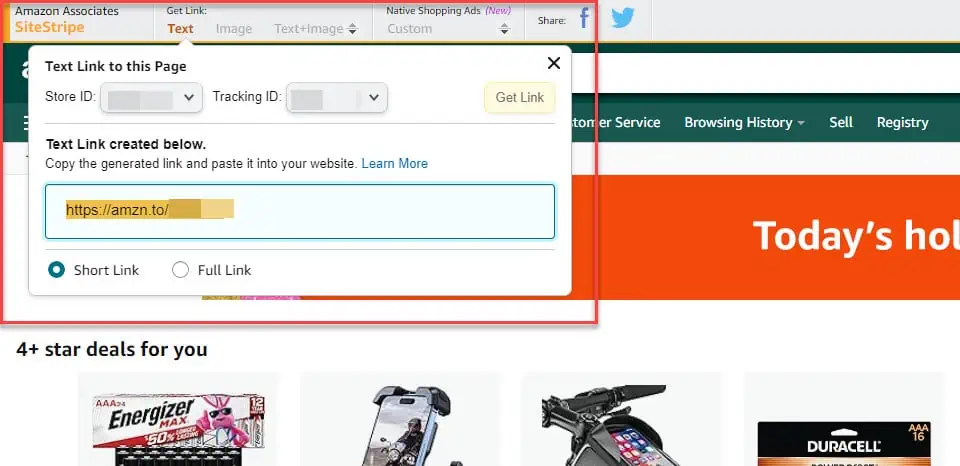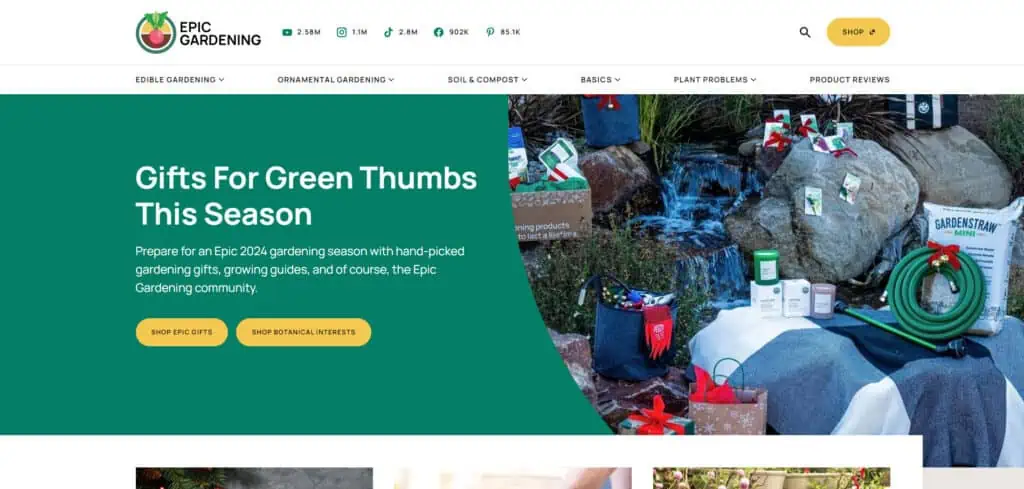Last Updated on 5 months by Christopher Jan Benitez
Are you interested in starting your affiliate marketing business by promoting products on this online marketplace? This comprehensive guide will walk you through everything you need to know to earn commissions through the Amazon Affiliate Program successfully.
You will learn strategies for selecting profitable products to promote, creating content that drives sales, and tracking your affiliate links for maximum visibility into performance. We cover best practices for optimizing your website and marketing efforts to recommend the right Amazon products to the right audiences.
By the end of this guide, you’ll have the knowledge to sign up for the Amazon Associates Program, launch your first affiliate campaigns, and scale your business over time. Let’s begin, shall we?
- Understanding the Amazon Affiliate Program
- Setting Up Your Amazon Affiliate Account
- Choosing the Right Products to Promote
- Creating Affiliate Links
- Promoting Affiliate Products on Your Platform
- Amazon Affiliate Program Policies and Guidelines
- Earning Commissions with Amazon Affiliate Program
- Optimizing Your Amazon Affiliate Strategy
- Overcoming Challenges in Amazon Affiliate Marketing
- Case Studies of Successful Amazon Affiliates
- Frequently Asked Questions
- How do I sign up for the Amazon Affiliate Program?
- What is the commission structure for Amazon Affiliates?
- Are there specific requirements to join the Amazon Affiliate Program?
- How do I create Amazon Affiliate links?
- What is the Amazon Influencer Program?
- Can I become an Amazon Affiliate without a website?
- Conclusion
Understanding the Amazon Affiliate Program

The Amazon’s Affiliate Program, also known as Amazon Associates, is a widely popular affiliate marketing program that allows content creators, publishers, and bloggers to monetize their websites, blogs, or social media platforms. By placing links to Amazon products on their sites, Amazon Associates can earn commissions when customers make purchases.
To become an Amazon Associate, individuals must sign up for the program and fill out a brief online registration form. Once registered, users will gain access to Associates Central, a platform that offers easy-to-use link-building tools, merchandising tips, and other helpful resources.
The Amazon Affiliate Program offers a few key benefits:
- Wide Selection of Products – With millions of products and programs available on Amazon, Associates have an extensive range of items to choose from when creating links and promoting products.
- Flexible Linking Tools – Amazon provides various tools for building and customizing links, making it easier for Associates to tailor their recommendations to fit their audience’s preferences.
- Earning Potential – Amazon Associates earn a commission based on the qualifying purchases made by their referrals. This income can be a viable passive revenue stream, depending on the traffic generated and the user’s product promotion skill.
Amazon uses a performance-based commission structure with different rates for various product categories. Some categories offer higher percentages than others, so it is wise for Associates to focus on promoting products that align with their content while also considering the commissions they could receive.
It is essential for anyone participating in the Amazon Affiliate Program to follow the Associates Program Operating Agreement. This document outlines the terms and conditions for proper participation, as non-compliance could result in account termination and the forfeiture of earnings.
In summary, the Amazon Affiliate Program provides an attractive opportunity for content creators, publishers, and bloggers to monetize their websites and social media presence. By understanding the program’s workings and adhering to the required guidelines, Associates can effectively leverage their influence to generate income through product recommendations.
Setting Up Your Amazon Affiliate Account
Setting up an Amazon Associate account is a simple process that begins with signing up for the Amazon Associates Program. This program allows creators, publishers, and bloggers to earn money by recommending and sharing millions of products with their audience.
When starting, follow these steps:

- Visit the Amazon Associates Program website and click on the Sign up button.
- Fill out the brief online registration form, providing your personal and payment information.
- After completing the registration, you’ll gain immediate access to Associates Central, which is Amazon’s affiliate dashboard.
Associates Central is the hub for all affiliate-related activities. It provides a variety of resources, such as:
- Link-building tools to create customized links for large publishers, individual bloggers, and influencers.
- Reporting tools to monitor the performance of your affiliate links and earnings.
- Promotional resources, such as banners and widgets, to enhance your website’s appearance and maximize earnings.
Once you’ve set up your account, it’s essential to complete the following tasks:
- Enter your tax information, as this ensures you get paid correctly.
- Verify your contact information to receive important updates and notifications.
As you explore Associates Central, you can create links to Amazon products using the Build Links section. This feature allows you to generate customized affiliate links to any page on Amazon. You may add up to 540 products per category page to your website.
Remember to follow the Amazon Associates Program Operating Agreement to stay compliant and maintain a successful affiliate relationship with Amazon.
By thoroughly setting up your Amazon Affiliate account, you’re taking the first necessary steps to grow your online business and earn passive income.
Choosing the Right Products to Promote

As part of the Amazon Affiliate Marketing Program, selecting the appropriate products for your target audience is crucial to maximize your earning potential. Here are a few guidelines to help you make the right choices:
- Relevance – Ensure the products you promote relate to your website’s theme or niche. For instance, if your website is about fitness equipment, promoting fitness-related products would make more sense than promoting unrelated items like electronics.
- Customer Needs – Understand the needs of your target audience and find products that cater to their requirements. Keeping track of your niche’s latest trends, products, and updates is essential, as this information can help you choose the most suitable items to promote.
- Product Quality – Product quality is an essential factor to consider. Choose products with good ratings and positive reviews, which can help convert more sales and gain your audience’s trust.
- Price Range – Promoting products in various price ranges is wise, as this caters to a broader range of audience budgets. However, focusing on higher-priced items can result in higher commission rates.
- Commission Rates – Amazon’s Affiliate Marketing Program offers different commission rates for product categories. It is a good idea to check the categories with higher commission rates for potential products to promote.
A helpful way to sort the products according to the above guidelines is by creating a table for easy comparison:
| Product | Relevance | Customer Needs | Quality | Price | Commission Rate |
|---|---|---|---|---|---|
| A | Yes | High | 4.3/5 | $$$ | 6% |
| B | Yes | Medium | 4/5 | $$ | 4% |
| C | No | Low | 3.4/5 | $ | 4% |
Creating Affiliate Links
The Amazon Affiliate Program allows content creators, publishers, and bloggers to earn commission by promoting Amazon products. Creating accurate and relevant affiliate links is a crucial part of this process. In this section, we will discuss different methods to generate Amazon affiliate links and the usage of tools provided by Amazon.

One popular tool is SiteStripe. This Amazon browser extension allows you to create affiliate links directly from any Amazon.com page. After adding the SiteStripe extension to your browser and logging in with your Amazon Influencer or Associate credentials, you can instantly generate affiliate links and share them with your audience.
Another helpful method is the Product Link Tool. This tool is accessible from the Amazon Associates dashboard. Click “Product Linking” at the top and select “Product Links.” The process involves searching for products, selecting the desired one, and customizing the link according to your preferences. This is the most common way to create an Amazon affiliate link.
For those who prefer building their affiliate links manually, here is a step-by-step guide:
- Log in to your Amazon Associates account.
- Copy the product’s ASIN (Amazon Standard Identification Number) or URL.
- Use the following link format to create your affiliate link: https://www.amazon.com/dp/ASIN/?tag=your-associate-id
- Replace ASIN with the product’s ASIN or the appropriate part of the URL, and your-associate-id with your Amazon Associates ID.
Here’s a comparison of the mentioned methods:
| Method | Ease of Use | Customization | Recommended For |
|---|---|---|---|
| SiteStripe | Easy | Limited | Casual creators, social media influencers |
| Product Link Tool | Moderate | High | Bloggers, publishers, professional marketers |
| Manual Link Building | Advanced | High | Experienced users, niche affiliate marketers |
Promoting Affiliate Products on Your Platform
One of the key aspects of succeeding with the Amazon Affiliate Program is effectively promoting affiliate products on your chosen platform. This section will discuss three popular promotion methods:
Blogging

Blogging is an excellent way to promote Amazon affiliate products. By creating high-quality content that appeals to your target audience, you can effectively include affiliate links within your blog posts. Here are some tips for successful blogging:
- Choose a niche – Focusing on a specific niche allows you to create targeted content that appeals to a particular audience, increasing your chances of earning commissions.
- Write product reviews – Provide honest and valuable reviews of Amazon products relevant to your niche, offering pros and cons.
- Create comparison posts – Compare similar products to help your audience make informed decisions.
- Use SEO techniques – Optimize your blog posts for search engines to increase visibility and attract organic traffic.
Social Media Marketing

Social media platforms provide an excellent opportunity to promote Amazon affiliate products to a broader audience. Here’s some guidance for effective social media marketing:
- Engage with your audience – Interact with your followers regularly, answer their questions, and provide valuable content that resonates with them.
- Use eye-catching visuals – High-quality images and videos can help grab attention and drive engagement.
- Post consistently – A regular posting schedule helps maintain audience interest.
- Utilize hashtags – Use relevant hashtags to increase discoverability.
| Social Media Platform | Tips for Affiliate Promotion |
|---|---|
| Create a dedicated page or group, share links in context with valuable content | |
| Use affiliate links in bio, Instagram Stories, and create shoppable posts (if applicable) | |
| Leverage the power of concise, engaging tweets with relevant hashtags | |
| Design attractive pins linking back to your blog posts or affiliate products. |
Email Marketing

Email marketing provides a direct avenue to promote Amazon affiliate products to your subscribers. Building a loyal audience can increase the likelihood of earning commissions. Keep these practices in mind:
- Build a solid and engaged subscriber base – Encourage your website visitors to subscribe by offering valuable, relevant content or incentives.
- Personalize your emails – Address your subscribers by name and tailor content to their preferences based on browsing and purchase history.
- Segment your list -Create targeted segments based on subscriber interests to boost engagement and conversions.
- Regularly test and analyze -Monitor the performance of your emails and implement adjustments to improve results.
Amazon Affiliate Program Policies and Guidelines
The Amazon Affiliate Program, also known as the Amazon Associates Program, is a popular way for creators, publishers, and bloggers to monetize their online content. To maintain its effectiveness and adhere to legal requirements, there are a variety of policies and guidelines that participants must follow.
The program’s policies are incorporated by reference in the Associates Program Operating Agreement. Participants must identify themselves as an Amazon Associate on their website, using the language required by the Operating Agreement. This identification is critical to be transparent and comply with the Federal Trade Commission (FTC) regulations.
To ensure compliance, link-level disclosures must be clear. Amazon Affiliates must include a legally compliant disclosure with each link identifying their relationship to Amazon. This disclosure is necessary to inform the audience that the affiliate may earn a commission from any qualifying purchases made via the link.
Qualifying purchases refer to sales of products that fall under different commission rates based on the specific product categories. This means that affiliates should know these categories, as earnings will vary accordingly. For instance, the standard commission income is limited to a maximum of $200 per product for Fine Art Products. In contrast, Free Book Promotions do not offer any commissions.
Amazon Affiliates need to avoid making exaggerated or false claims regarding the products they promote and their earnings potential. This will help maintain the program’s integrity and uphold the trust between affiliates, Amazon, and the customers involved.
Earning Commissions with Amazon Affiliate Program
The Amazon Affiliate Program, also known as Amazon Associates, provides a way for website owners, influencers, and content creators to generate revenue by promoting Amazon products on their platforms. When visitors follow affiliate links from the participant’s site to Amazon and make a purchase, the affiliate earns a commission.
Associates can earn up to 10% commissions from qualifying purchases and programs. The program features competitive conversion rates, helping maximize earnings for affiliates. To increase earnings, promoting a wide range of relevant products and using easy-to-use tools provided by Amazon to create customized links is essential.
Commission rates vary depending on the product category. Below is a list of popular categories and their respective commission rates:
- Electronics: 4%
- Home & Garden: 8%
- Fashion: 7%
- Toys & Games: 3%
Amazon aims to pay commission income when affiliates refer unrelated customers to their platform. It is important to note that affiliates who refer family members, friends, or close acquaintances may not receive advertising commissions for those purchases.
In addition to promoting individual products and pages, affiliates can also place product search boxes on their sites, directing users to Amazon search results pages. This increases the chances of users finding relevant products and making purchases, thus boosting the affiliate’s commission earnings.
Optimizing Your Amazon Affiliate Strategy
Keyword Research

Successful Amazon affiliate marketers begin with keyword research. Identifying high-traffic, low-competition keywords related to the products you’re promoting will help your content rank higher in search engine results. To conduct keyword research, use the best free tools available for now.
Create a list of keywords with a good mix of long-tail and short-tail variations. Focus on incorporating these keywords throughout your content to improve visibility in organic search results. This will help drive more traffic to your site and increase the chance of generating sales through your affiliate links.
A/B Testing
A/B testing is a method of comparing two or more variables in a controlled environment to determine which performs better. This technique can be utilized to optimize your Amazon affiliate strategy by testing variations of:
- Call-to-action (CTA) buttons
- Headlines
- Text or image-based affiliate links
- Product placement
By performing A/B tests and analyzing the results, you can optimize your website or content to engage visitors better, driving more clicks on your affiliate links and ultimately increasing sales. Continuously testing and refining your strategy will help you maximize your earning potential.
Performance Tracking
Keeping track of your affiliate marketing performance is crucial for growth and scalability. Use performance tracking tools and analytics to:
- Monitor clicks on affiliate links
- Evaluate conversion rates
- Calculate your earnings
- Identify low-performing content
Some useful tools for performance tracking include:
- Amazon Associates Central (for campaign-specific metrics)
- Google Analytics (for website traffic and user behavior)
Overcoming Challenges in Amazon Affiliate Marketing
Amazon Affiliate Marketing is an excellent opportunity for marketers to generate passive income by promoting products on their websites, blogs, or social media platforms. However, the road to success has its challenges. This section discusses some key challenges and suggests effective strategies to overcome them.
Challenge 1: Niche Selection

Finding the right niche is essential for the success of any affiliate marketing campaign. The ideal niche should align with your interests and expertise and have a sufficient market demand.
Solution: To select the relevant niche, consider the following factors:
- Your passion and knowledge of the subject
- Market demand and competition
- Profitability and your desired level of commitment
Challenge 2: Generating High-Quality Traffic

Attracting quality traffic is a major hurdle for most affiliate marketers, as it directly contributes to your conversions.
Solution: Adopt a multi-dimensional approach to increase traffic:
- Create high-quality, engaging content that resonates with your audience
- Optimize your website for search engines (SEO)
- Leverage social media platforms to promote content
- Use email marketing to engage with your subscribers and offer valuable resources
Challenge 3: Competition
The Amazon Affiliate Marketing landscape is highly competitive, making it difficult for new entrants to carve out a niche.
Solution: To stay ahead of the competition, you must:
- Focus on a niche with less competition but high demand
- Offer unique content that is different from your competitors
- Continuously update and improve your marketing strategies
Challenge 4: Diversify Income Streams

Relying solely on Amazon Affiliate Marketing can pose risks, especially if Amazon decides to change its commission rates or alter its policies.
Solution: Consider incorporating other monetization strategies:
- Promote products from other affiliate programs
- Add display ads to your website
- Offer sponsored content or collaborations
By implementing these solutions, you can effectively overcome the challenges in Amazon Affiliate Marketing and set yourself on the path to success.
Case Studies of Successful Amazon Affiliates

Epic Gardening is an inspiring example of a successful Amazon affiliate website. Within just seven years, this gardening blog dominated its niche completely. Established in 2013, Epic Gardening significantly increased its earnings from $400 per month to $4-5k monthly in a few years. They succeeded by providing valuable content to their audience, focusing on gardening tips and techniques.
Another noteworthy success story is an Amazon Affiliate website that generated $2,000 per month with only 100 articles. The website owner strategically researched and created high-quality blog posts to promote Amazon products, resulting in a significant income through affiliate marketing. This case study highlights the importance of carefully selecting profitable niches and producing engaging well-researched content.
By studying these success stories, aspiring Amazon affiliates can gain insights into different strategies and tactics that have proven effective in generating income through the Amazon Affiliate Program.
Frequently Asked Questions
How do I sign up for the Amazon Affiliate Program?
To sign up for the Amazon Affiliate Program, navigate to affiliate-program.amazon.com and complete the online registration form. Read the Amazon Associates Program Operating Agreement and provide the required details about your business and audience.
What is the commission structure for Amazon Affiliates?
The commission structure for Amazon Affiliates varies based on the product category and specific promotions. Commissions can range from 1% to 10%, with higher rates for particular categories and promotions. Reviewing the Amazon Associates Program Fee Schedule for accurate and up-to-date commission rate information is essential.
Are there specific requirements to join the Amazon Affiliate Program?
While no strict prerequisites exist for joining the Amazon Affiliate Program, your application will require information about your business and audience. It is essential to have a platform, such as a website, blog, or social media presence, to share product links and earn commissions. Amazon may review your application based on your traffic, audience engagement, and the extent to which your content is relevant to their products.
How do I create Amazon Affiliate links?
After becoming an Amazon Affiliate, create affiliate links using Amazon Associates Central. Search for products in the Amazon Associates Central dashboard and generate a customized link using the available linking tools. You can then share these links on your platform and earn commissions on qualifying purchases made through these links.
What is the Amazon Influencer Program?
The Amazon Influencer Program is a particular branch of the Amazon Affiliate Program designed for individuals with large social media followings. Influencers can create a personalized storefront on Amazon to recommend products and earn commissions. Influencers typically need to have a significant following on platforms such as Instagram, YouTube, Twitter, or Facebook to qualify.
Can I become an Amazon Affiliate without a website?
Yes, you can become an Amazon Affiliate without a website. Some affiliates leverage their social media presence or email marketing lists to share affiliate links. However, using a website or blog allows for more excellent monetization opportunities and can help create an engaged audience, which is vital for a successful affiliate marketing program.
Conclusion
Affiliate marketing is a marathon – building an audience, creating high-quality content, and seeing consistent earnings takes time. Be patient, test different strategies, and constantly work to improve your process.
As you continue learning and refining your approach, your commissions will grow over the long run. Don’t get discouraged by short-term fluctuations – stay focused on creating value for your readers, and they will reward you through purchases. Consider this guide a starting point on your Amazon affiliate journey.
Continue learning from other successful affiliates, explore new tactics as the program evolves, and you’ll be well on your way to profiting from the massive Amazon marketplace.

